“Despite the challenges our industry has faced over the past two years, our team has continued to embrace the ever-changing market and build successful projects for our clients. As we look forward to 2022, I have no doubt they will continue to set us apart from the competition and meet the challenges of the industry head-on. Our employees are our most important resource and I appreciate their commitment to Branco.”
– Justin Branham, President
“Rapidly changing environment” is a phrase we have had heard many times over the past couple of years. It’s a concept we’ve embraced and will continue to do so in the coming year. In 2021, our industry dealt with supply chain disruptions, labor challenges, materials shortages, and ever-changing safety regulations. However, despite these challenges, our industry has continued to experience growth. That is not expected to change in 2022. In addition to pivoting on a moment’s notice and experiencing continued growth, the following explore additional areas of concentration moving forward.
Skilled Labor
A skilled labor shortage will continue to be a concern. For most of last year, jobs were stagnant in construction, according to numbers from the Bureau of Labor Statistics. Construction began the year with roughly 7.4 million jobs, seasonally adjusted, and the last report in November indicated 7.5 million jobs. That’s the closest the construction industry’s employment numbers have been to pre-pandemic levels since March 2020, when the industry employed 7.6 million workers.
Apprenticeship programs, like the Branco Carpentry Apprenticeship program, on-the-job training, and workforce development initiatives will be crucial as we work to fill workforce gaps. Skilled workers are retiring at a pace faster than we can replace them. Companies will need to be creative and proactive in engaging students to explore career opportunities in the trades.
Communication
As always, communication will be key at every phase of a project. There will be times when things arise that are simply out of our control. The past two years are perfect examples. Clear and honest communication has proven to be the best way to handle these issues. We frequently tell our clients, we may not always tell you what you want to hear, but we will always tell you the truth and work with you to come up with an effective solution. As we continue to navigate these new waters, we must be proactive and thorough in our communication efforts with not only the project owner, but the architects, subcontractors, and any other project stakeholders.


